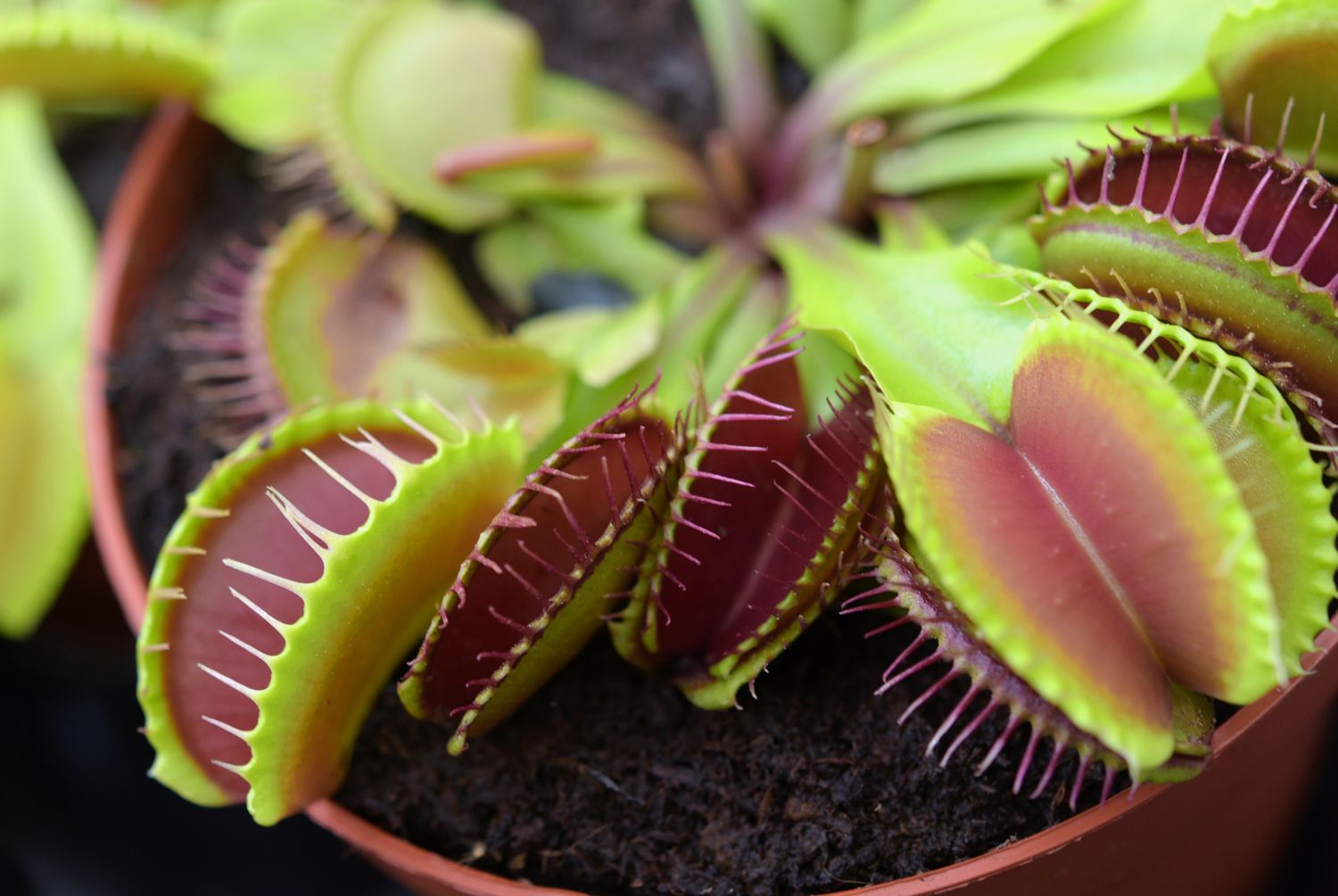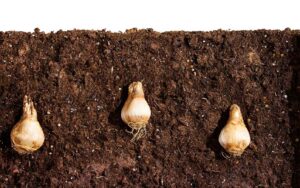Know About Caring for Venus Flytraps: The Complete Guide
Venus flytraps (Dionaea muscipula) are fascinating carnivorous plants that capture the imagination with their unique snap-trap mechanism. Native to the wetlands of North and South Carolina, these remarkable plants have become popular houseplants across the US. Whether you’re a beginner looking to purchase your first flytrap or an enthusiast wanting to perfect your care routine, this comprehensive guide will cover everything you need to know about successfully growing and maintaining healthy Venus flytraps.
Understanding Venus Flytraps
Natural Habitat and Adaptations
Venus flytraps evolved in nutrient-poor bog environments where they developed their carnivorous nature as an adaptation to supplement their diet. According to the U.S. Fish and Wildlife Service, these plants are found naturally in a small region spanning approximately 75 miles around Wilmington, North Carolina, in wet, sandy soils with high acidity and low nutrients (FWS.gov).
In their natural habitat, Venus flytraps receive:
- Full sun exposure
- Consistent moisture
- Poor soil nutrients
- Seasonal temperature variations
- High humidity
Understanding these natural conditions is crucial for replicating an environment where your Venus flytrap can thrive. The plant’s famous trapping mechanism is actually a modified leaf that has evolved specialized sensory hairs. When an insect touches these trigger hairs multiple times within seconds, the trap closes rapidly, capturing the prey for digestion.
Conservation Status
Venus flytraps are considered vulnerable in the wild due to habitat loss, poaching, and climate change. The U.S. Department of Agriculture has listed them as a species of concern, with conservation efforts ongoing to protect their native habitats.
Essential Care Requirements
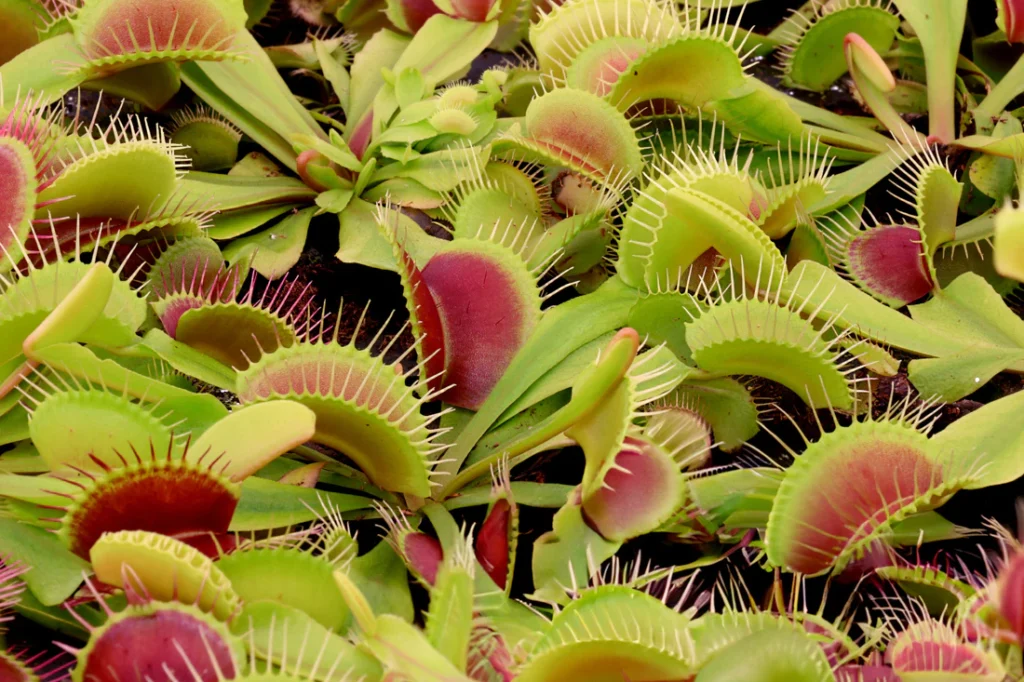
Light and Temperature
Your Venus flytrap requires abundant light to thrive. These plants have evolved to grow in open, sunny bogs, and replicating these light conditions is critical for their health.
| Light Requirement | Details | Seasonal Variations |
|---|---|---|
| Direct Sunlight | 6+ hours daily | More in winter, less intense in summer |
| Window Placement | South or west-facing window | East-facing in summer to prevent burning |
| Artificial Lighting | Full-spectrum grow lights | 14-16 hours daily if natural light insufficient |
| Signs of Inadequate Light | Elongated leaves, weak traps, pale coloration | Adjust lighting if observed |
| Signs of Too Much Light | Browning/scorching of leaves | Provide filtered light during intense summer days |
Temperature requirements for Venus flytraps vary throughout the year as they naturally experience seasonal changes:
- Growing Season (Spring/Summer): 70-85°F (21-29°C)
- Fall Transition: 55-70°F (13-21°C)
- Dormancy Period (Winter): 35-50°F (2-10°C)
Providing this temperature cycle is essential for long-term health. According to research from the USDA Plant Hardiness Zone Map, Venus flytraps are typically hardy in zones 8-10 but can survive brief freezes when properly acclimated (USDA.gov).
Water and Soil Requirements
Perhaps the most critical aspect of Venus flytrap care is water quality. These plants are extremely sensitive to minerals and chemicals found in tap water.
| Water Type | Suitability | TDS Range | Notes |
|---|---|---|---|
| Distilled Water | Excellent | 0-5 ppm | Best choice for long-term care |
| Rainwater | Very Good | Typically 5-20 ppm | Collect in clean containers away from pollution |
| Reverse Osmosis | Very Good | 0-10 ppm | Requires special equipment |
| Deionized Water | Good | 0-5 ppm | Can be expensive for regular use |
| Bottled Water | Variable | Check label | Only use if labeled “distilled” |
| Tap Water | Poor | 50-300+ ppm | Contains harmful minerals and treatments |
| Filtered Water | Usually Unsuitable | 30-100+ ppm | Most filters don’t remove enough minerals |
| Softened Water | Harmful | High sodium content | Will kill Venus flytraps over time |
For soil, Venus flytraps require extremely nutrient-poor, acidic growing media. The ideal mix is:
- 1 part sphagnum peat moss
- 1 part perlite or coarse silica sand
Never use:
- Potting soil
- Garden soil
- Miracle-Gro or other fertilized soils
- Compost
- Topsoil
These standard soils contain too many nutrients and will harm or kill your plant. The National Park Service recommends maintaining soil pH between 4.0 and 5.0 for optimal growth (NPS.gov).
Feeding Your Venus Flytrap
Natural Prey vs. Manual Feeding
In their native habitat, Venus flytraps primarily catch small insects like ants, flies, spiders, and beetles. While indoor Venus flytraps can survive without catching prey, occasional feeding helps them thrive.
If you choose to manually feed your plant:
- Select small, live insects (fruit flies, small crickets, or mealworms)
- Place the insect in an open trap
- Gently stimulate the trigger hairs with a toothpick to close the trap
- Only feed one or two traps every 2-4 weeks
- Don’t feed more frequently than this as digestion requires energy
Important feeding rules:
- Never feed your Venus flytrap meat, cheese, or other human foods
- The prey should be no larger than 1/3 the size of the trap
- Don’t force traps closed manually
- Don’t feed during dormancy
Fertilization
Traditional fertilizers will harm or kill Venus flytraps. Their specialized adaptations evolved specifically to extract nutrients from insect prey rather than from soil. If your plant appears weak or pale, focus on improving light conditions rather than adding fertilizers.
For advanced growers, extremely diluted fertilizers (1/4 strength) can occasionally be applied directly into traps instead of prey, but this technique is generally unnecessary and risky for beginners.
Venus Flytrap Dormancy
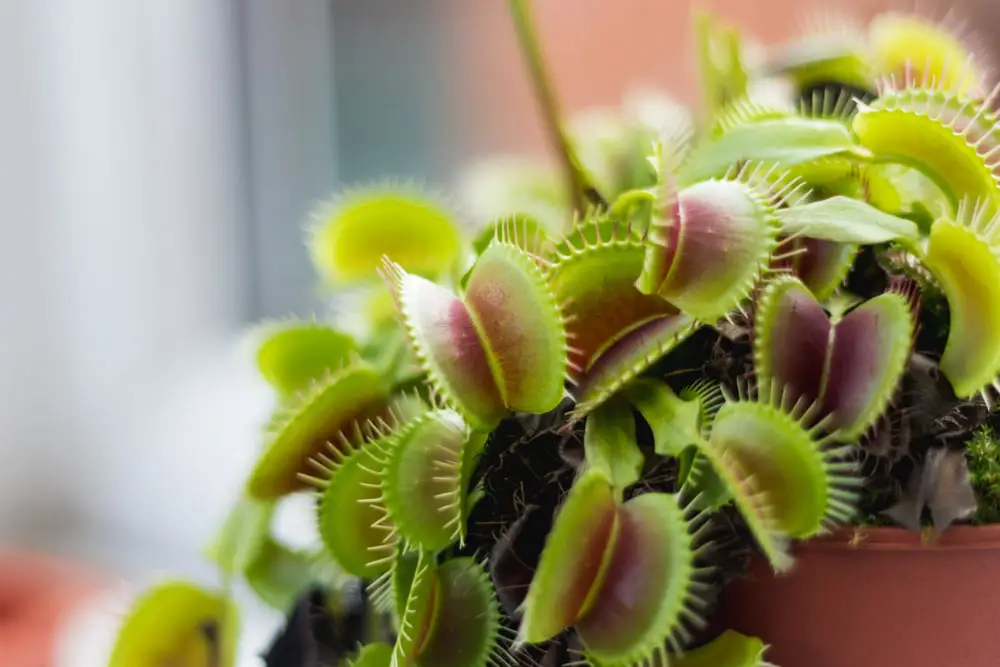
Understanding the Dormancy Cycle
One of the most frequently overlooked aspects of Venus flytrap care is their need for a winter dormancy period. In their natural habitat, these plants experience cooler temperatures and shorter days during winter months, triggering metabolic changes that are essential for long-term health.
During dormancy (typically November through February in the Northern hemisphere), your Venus flytrap will:
- Produce smaller, slower-growing traps
- Have reduced trap activity
- Die back partially or completely above ground
- Focus energy on root development
- Reset its growth cycle for the coming season
A Venus flytrap denied proper dormancy may continue growing throughout winter but will gradually weaken over subsequent years and eventually die.
How to Provide Proper Dormancy
To provide appropriate dormancy conditions:
- Reduce lighting: Place in a location with natural shortened daylight hours
- Lower temperatures: Maintain between 35-50°F (2-10°C) for 3-4 months
- Reduce watering: Keep soil just barely moist, not wet
- Stop feeding: Do not feed during dormancy period
- Monitor health: Check occasionally for mold or rot
According to the U.S. Botanic Garden, dormancy is triggered primarily by reduced daylight hours rather than temperature alone, though both factors play important roles (USBG.gov).
Common dormancy locations include:
- Unheated garage (not below freezing)
- Cool basement
- Refrigerator (in plastic bag with small air holes)
- Protected outdoor area (zones 8-10)
Propagation Methods
Seed Propagation
Growing Venus flytraps from seeds requires patience as they take 3-5 years to reach maturity. Seeds can be collected from your own plants or purchased from reputable sources.
To grow from seed:
- Sow seeds on the surface of appropriate carnivorous plant soil
- Keep consistently moist with appropriate water
- Maintain high humidity with a humidity dome or plastic wrap
- Provide bright, indirect light
- Expect germination within 2-4 weeks
- Remove covering once seedlings establish
Division Propagation
The easiest and fastest method of propagation is through rhizome division:
- During repotting in early spring, gently remove the plant
- Look for natural divisions in the rhizome (underground stem)
- Carefully separate clusters that have at least 3-4 traps each
- Replant each division in fresh carnivorous plant soil
- Keep extra moist for 2-3 weeks to encourage establishment
Leaf Pulling
More advanced growers can try leaf pulling:
- Select a healthy outer leaf
- Pull downward, ensuring you get the whitish part at the base
- Place on moist carnivorous plant soil
- Cover with a humidity dome
- Wait several months for tiny plants to form
Common Problems and Solutions
Venus flytraps can experience various issues, most relating to improper growing conditions.
Disease and Pest Issues
While Venus flytraps don’t suffer from many pests (they eat them!), they can encounter problems:
- Fungal diseases: Caused by poor air circulation and excessive moisture. Treat with diluted fungicide formulated for sensitive plants.
- Aphids: Can sometimes infest new growth. Remove manually or treat with insecticidal soap away from traps.
- Spider mites: Indicated by fine webbing. Increase humidity and use appropriate miticide.
- Mealybugs: White cotton-like pests. Remove with alcohol-dipped cotton swab.
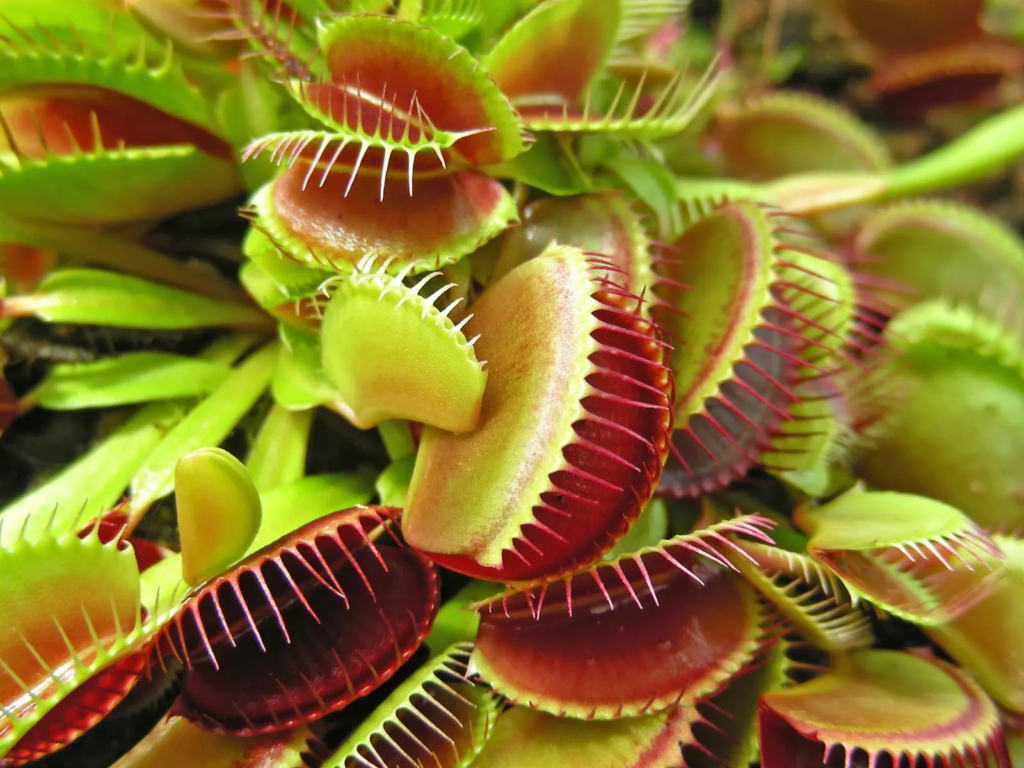
Troubleshooting Growth Problems
| Symptom | Potential Cause | Solution |
|---|---|---|
| Black traps | Natural die-off or over-feeding | Remove dead traps, reduce feeding frequency |
| Weak, floppy growth | Insufficient light | Gradually increase light exposure |
| No trap closure | Dormancy, trap fatigue, or poor health | Check season, allow traps to rest between feedings |
| Traps turning black after feeding | Prey too large or trap damaged | Feed smaller prey, be more gentle |
| All traps dying back | Possible dormancy or mineral poisoning | Check season, review water quality |
| Mushy stems/roots | Root rot from overwatering | Improve drainage, reduce watering frequency |
| White fuzzy growth | Mold or fungus | Improve air circulation, treat with fungicide |
| Traps not fully closing | Low humidity or trap fatigue | Increase humidity, allow rest between feedings |
| Deformed new growth | Pest damage or environmental stress | Check for pests, review growing conditions |
The US Venus Flytrap Market
The Venus flytrap market in the United States has seen steady growth, with these plants becoming increasingly popular houseplants. According to industry reports, carnivorous plants represent a growing specialty segment within the $17.7 billion US houseplant market.
Some notable trends:
- Increasing interest in unique houseplants during and after the pandemic
- Greater availability in big-box stores and garden centers
- Premium varieties commanding higher prices from specialty growers
- Growing concern about ethically sourced plants (not wild-collected)
When purchasing, look for:
- Healthy green coloration with some red interior in traps
- Multiple traps (at least 4-5 active)
- No signs of browning or damage
- Reputable seller with knowledge of proper care
- Certification that plants are nursery-grown, not wild-collected
Advanced Care Tips
For experienced growers looking to perfect their Venus flytrap cultivation:
Maximizing Trap Size and Coloration
To encourage larger, more dramatically colored traps:
- Provide maximum appropriate light (including some direct sun)
- Maintain high humidity (50-70%)
- Ensure proper dormancy cycle yearly
- Use only the purest water available
- Consider shallow, wide pots rather than deep ones
- Feed occasionally during active growth season
Creating the Perfect Microclimate
Advanced growers often create specialized environments:
- Terrariums with humidity control
- Bog gardens (indoor or outdoor in appropriate zones)
- Growing chambers with controlled lighting
The U.S. Department of Agriculture’s Agricultural Research Service has studied optimal growing conditions for Venus flytraps, finding that specific light wavelengths can enhance trap development and coloration (ARS.USDA.gov).
Conclusion
Caring for Venus flytraps can be incredibly rewarding once you understand their unique needs. By replicating their natural growing conditions – providing appropriate light, pure water, poor soil, and a natural dormancy period – you can enjoy these fascinating carnivores for many years. Remember that these plants have evolved to thrive in very specific conditions, and deviating from these requirements is the most common cause of failure.
As interest in these remarkable plants continues to grow across the US, more resources are becoming available to help you succeed in your Venus flytrap journey. Conservation efforts for their native habitats also help ensure that wild populations will continue to exist for future generations to appreciate.
Whether you’re growing your first Venus flytrap or cultivating an extensive collection, applying the principles in this guide will help you develop healthy, vibrant plants with impressive trapping capabilities.
